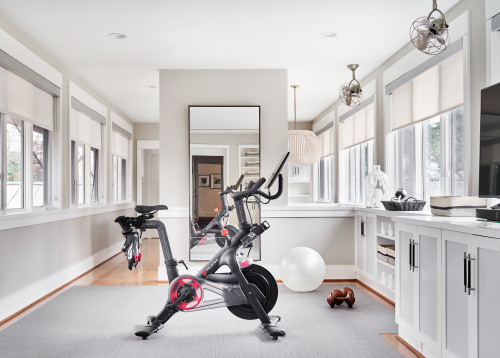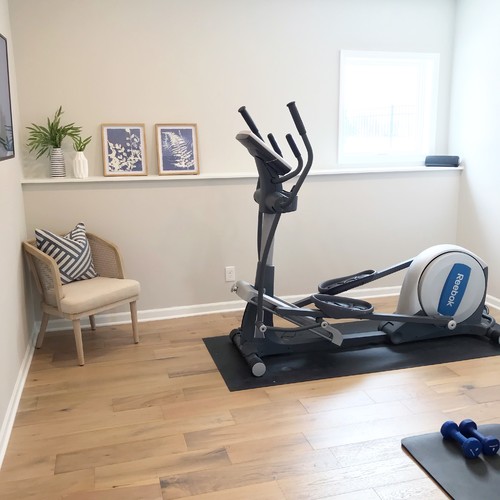
monkeybusinessimages/iStock
Every year, top resolutions for the New Year include working out more and losing weight. Going to the gym is one way to meet these goals. However, a monthly membership can really inflate your budget. Plus, schlepping to and from the gym, whatever the weather, can get even more tiresome than the workouts themselves.
With a home gym, on the other hand, you can exercise at your convenience in the comfort of your own home—using the type of equipment that you like.
But it’s not quite that easy: If you don’t design the space properly, you won’t want to work out there, either. So don’t waste time, money, and valuable square footage—avoid the following mistakes when setting up your home gym.
1. Choosing fashion over function
We get it: You want a nice-looking gym in your nice-looking home. However, focusing on fashion over function is a major design mistake.
“Is your gym something to simply admire and show off to your guests, or is it meant to be a place where you sweat and work out?” asks exercise physiologist Tom Holland, a Bowflex fitness adviser and the author of “Beat the Gym.”
He says that many people design their home gyms as beautiful spaces, focusing on aesthetics rather than functionality.
“Buying an expensive rack of chrome dumbbells that take up an entire wall may look amazing, but you can purchase one set of adjustable dumbbells that will replace that entire rack,” Holland says.
“The look, layout and equipment selected should maximize the space while giving you the best workout possible based on your personal tastes and goals.”
2. Ignoring the flooring
Flooring in your home gym should be one of your first considerations. But, according to Jamie Safier, a luxury real estate agent at Douglas Elliman in NYC, people often skip this step.
“Do you want to do situps or jumping jacks on cold marble? Do you want to sweat on wall-to-wall carpet?” Safier asks. Um, no.
“Rubber flooring is best on the joints, and there are even some high-end ones now that give the look of hardwood,” he says.
Make sure that whatever you choose is waterproof and has texture, so you don’t slip.
3. Putting the gym in the basement or garage
Basements and garages are popular locations for home gyms. However, if you don’t make the space inviting, you’ll never want to go in there. Also, lighting and ventilation are crucial.
“Natural light is ideal, though that might not be possible in a basement, so think about putting in a faux window or skylight,” says Dan DiClerico, home expert at Home Advisor. He also recommends painting the space a bright white or cheerful color, to make the room more inviting.
If the gym is in a damp area, DiClerico suggests using a dehumidifier to reduce mold and mildew. It’s also worth installing an air purifier to remove dust mites, dander, and other pollutants, he says.
4. Skimping on power
You’ll probably want several types of equipment in your home gym. But according to Don Powers, president and CEO of Fitness Machine Technicians, it’s a mistake to overlook your electrical needs.
“Each machine should have a dedicated outlet—plugging two exercise machines into one outlet can strain the power, weakening the performance of the machines and risking electrical harm,” Powers explains.
5. Going overboard with equipment
Peloton, Bowflex, Tonal … the list of fancy home gym equipment goes on and on. But in choosing what to put in your gym, don’t get carried away. Be realistic about the activities you’ll do on a consistent basis.
“It is better to start small—with some small free weights and one machine, versus an entire suite of equipment—and build upon your design as your commitment to working out at home is evident and proven over time,” says Leigh Spicher, national director of design studios for Ashton Woods.
Also, avoid buying a large piece of equipment that can’t be used by every member of your family.
“The bigger the piece of equipment, the more you should be able to do with it, and the more family members that should want to use it,” says Holland.
6. Putting the gym on the second floor
We realize you may have limited options for the home gym’s location. However, if you put it in the wrong place, you’ll regret your decision.
“Beyond the obvious hassle of getting your new Peloton or Nordic Track up the stairs, some floors have weight limitations and need structural reinforcement before adding heavy racks, weights, and equipment,” says Spicher.
Quite apart from structural issues, there’s another potential problem with choosing the wrong location.
“Be sure you will not be doing burpees or box jumps above the baby’s nursery or your spouse’s office,” says Paul Johnson, founder of Complete Tri. Extra insulation can help, but he says it’s hard to avoid the sound entirely unless the building is constructed from concrete.
The post 6 Home Gym Design Mistakes That Can Sabotage Your Workout—and Waste Money appeared first on Real Estate News & Insights | realtor.com®.


No comments:
Post a Comment